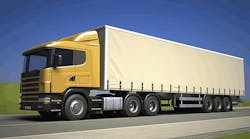The Coalition for Transportation Productivity (CTP), a group of nearly 200 of the manufacturers, shippers, carriers and allied associations, is urging members of Congress to review data from the U.S. DOT’s Comprehensive Truck Size & Weight Limits Study and then take action to reform interstate vehicle weight limits for six-axle trucks. CTP sent a letter to members of Congress as well as a one-pager highlighting key data from the U.S. DOT’s technical findings, which demonstrate the safety of heavier, six-axle trucks, as well as reduced logistics costs, pavement life-cycle costs, fuel costs, vehicle miles traveled, congestion, and emissions associated with their use.
In his letter to Congress, CTP Executive Director John Runyan writes: “The actual study data provides strong support for allowing trucks equipped with six axles to carry more freight on interstate system highways. This is the real message for Congress, despite the fact that U.S. DOT political leadership, after three years of study and 1,100 pages of released data, wrote a cover letter citing insufficient information and recommending against any changes in truck size and weight regulations. While the Administration could not find a political path to support truck weight reform, we urge members of Congress to review the study findings for themselves and allow carefully crafted reforms in vehicle weight regulation to move forward.”
In its letter and accompanying one-pager, CTP cites U.S. DOT technical findings that six-axle trucks weighing either 91,000 or 97,000 pounds maintain key braking and handling characteristics, allowing them to safely ship more freight and reduce vehicle miles traveled, logistics and pavement costs, and environmental impacts. The technical report also finds that the use of these vehicles would lead to a minimal diversion of freight from rail to truck, which would be more than offset by projected freight rail growth.
CTP also notes that while the U.S. DOT justified its call for inaction by referencing a higher crash rate for six-axle trucks operating over a limited time period in the state of Washington, the technical report also shows that none of those accidents involving six-axle trucks were fatal. In contrast, the study found that five-axle trucks weighing 80,000 pounds (the current federal gross vehicle weight limit) were involved in 10 fatal crashes in Washington State during the same period.
CTP supports carefully crafted truck weight reform giving each state the option to set higher interstate weight limits only for trucks equipped with six axles rather than the typical five. Because one-quarter of U.S. truck shipments meet the current interstate weight limit with space left in the trailer, this proposal would allow companies to meet demand with fewer vehicles and make the U.S. transportation network more efficient, especially as gross domestic product and population continue to grow.



